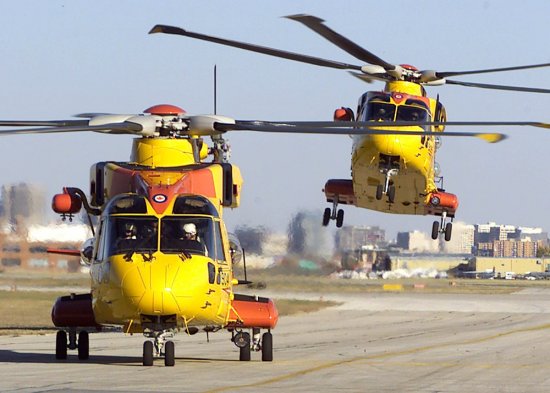In short order Captain Kleeman and the crew of Rescue 904 began preparations to proceed to the stranded jumper with their Cormorant Helicopter. Inclement weather and a low cloud deck prohibited Rescue 904 from flying directly to the scene. Instead they had to pick their way through the rugged mountain passes in near zero ambient illumination with the onset of nightfall.
Navigating with Night Vision Goggles (NVG) and instruments, the crew arrived in Revelstoke to refuel and meet with several ground rescue agencies to plan the next phase of the rescue.
As a result of the jumper’s precarious position, perched on a small ledge 300’ below the top of the cliff and 3000’ above the valley floor, it was agreed that the Cormorant was the only asset with a reasonable chance of success in victim recovery. The civilian pilot who had released the jumper earlier in the day would accompany the Cormorant crew to quickly pinpoint the jumper’s exact position to reduce recovery time. With a Buffalo aircraft dropping a steady stream of flares for illumination, Rescue 904 proceeded to the area of the stranded jumper. By this time the jumper had been clinging to a shallow ledge in minus ten-degree temperatures for eight hours wearing only light clothing; it was clear that he needed to be evacuated without delay. The jumper was quickly spotted and a hoist plan was created. After surveying the area, Captain Kleeman and his crew decided that a blind and extremely high hoist would be the only way to get a Search and Rescue Technician (SAR Tech) close to the stranded jumper.
Hovering 5’ from the cliff wall, the Flight Engineer deployed the SAR Tech down the hoist cable. The crew lost sight of the SAR Tech after he was 100’ below the aircraft and had to rely on conning commands through radio communications from the SAR Tech to guide the aircraft towards the stranded jumper. Finally, at 270’, very near the limit of the Cormorant hoist drum capacity, the SAR Tech radioed that he had visual contact with the jumper and issued his final conning commands to make physical contact. After making contact the aircraft was able to move away from the vertical wall and gain some separation. After the SAR Tech briefed the jumper on the recovery procedure he radioed to the crew that he was ready for pickup. Again the helicopter was forced to hover dangerously close to the cliff face in order to regain a safe position for the extraction. After the long hoist back into the helicopter, the jumper was treated for hypothermia and various injuries and transported to a nearby hospital.
The initiative and ingenuity that this crew displayed were beyond reproach. While SAR crews train for many different rescue scenarios that may challenge their capabilities, this rescue presented circumstances where only the very best airmanship, courage and crew cooperation resulted in a successful outcome.
The crew of the AgustaWestland EH101 CH-149 Cormorant Rescue 904 : Captain Hans Kleeman
Captain Rob Johnson
Master Corporal Brian Schoneberg
Sergeant Conrad Cowan
Master Corporal Dean Adams

See also:
